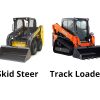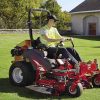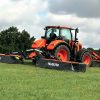Whether you’ve got a hobby farm or a good-sized operation, New Holland has a Roll-Belt™ round baler sized to meet your hay baling needs.Whether you’ve got a hobby farm or a good-sized operation, New Holland has a Roll-Belt™ round baler sized to meet your hay baling needs.
The Roll-Belt 450, 460, 550, and 560 balers are loaded with features and technology to make your life easier. Roll-Belt balers are designed to minimize your effort. Curved tines pick up the hay and feed it into a bale chamber to be tied and wrapped, while you monitor the process on your 10″ color touchscreen IntelliView™ monitor.
Balers with SuperFeed™ and CropCutter® rotary systems require even less effort. You can operate the drop floor without getting out of the cab.
New Holland Roll-Belt Baler Benefits
If high-tech and labor-saver features aren’t enough to convince you, there’s more!
- More power – 20% increase in belt strength, belt driving force, and capacity.
- Less stored product loss – Higher density bales + more capacity = reduced storage losses.
- Reduce moisture – Add CropSaver hay preservative to effectively bale at moisture up to 30%, even in wet conditions.
- Save time – Combine your New Holland Roll-Belt round baler with a Goweil bale wrapper and you can bale and wrap in one pass, cutting your time in half and saving fuel in the bargain.
So which baler fits your needs?
To figure it out, you’ll need to answer a few questions.
How much can your tractor handle?
Terrain and tractor configuration should be carefully assessed to determine the correct baler for you. Chances are, you may already have the tractor you plan to use for baling. As a general rule, if your tractor is:
- On the smaller end of 60hp to 100hp, you should choose the Roll-Belt™ round baler 450.
- Between 70hp and 105hp, the Roll-Belt™ round baler 450, 460, or 550 would work for you.
- 80hp or better, look at the Roll-Belt™ round baler 550 or 560.
How much extra weight can your trailer handle?
If you’re hauling the equipment around, you’ll need to know whether your trailer can handle the extra weight. Here’s what each piece weighs:
- Roll-Belt™ round baler 450 weighs 5,985 lbs.
- Roll-Belt™ round baler 460 weighs 6,553 lbs.
- Roll-Belt™ round baler 550 weighs 5,967 lbs.
- Roll-Belt™ round baler 560 weighs 7,450 lbs.
How much area do you need to cover?
Bigger bales means less time spent in the field, so if you have a large area and a big tractor, you can cut down on time with a bigger baler. The 450 and 460 balers make 46.5 inch wide bales that weigh 400 to 2,300 lbs each. The 560 makes bales that are 61.5 inches wide and weigh 500 to 2,500 lbs. The 550 offers less variability, and produces bales of 61.5 width weighing 1,550 lbs.
So let’s say you’re baling 5 acres of hay in a more or less standard rectangle (one furlong by one chain): 660 feet x 66 feet. So you’re traveling the shorter distance with each pass, 330 feet. With a 450 or 460, you’ll make 71 passes to cover the entire 5 acre field. With the 550 and 560, you’ll make 54 passes to cover the same ground. That’s a lot of time saved!
Working on hilly terrain?
New Holland recommends the Roll-Belt™ 550 baler. It has the capacity and stability of the 560 model but with a lower price, and it’s designed to be the ultimate baler in rolling terrain.
If you’re working in mountainous Georgia terrain, choose a 450 or 460 model for smaller bale sizes. The fields may be gently rolling, but larger bales would be very difficult to handle with the average tractor size in our geographic area. Hauling these large round bales on a trailer can prove hazardous on our narrow, curvy roads.
Here’s a comparison chart to compare specs.
| Category | Specs | Roll-Belt™ round baler 450 | Roll-Belt™ round baler 460 | Roll-Belt™ round baler 550 | Roll-Belt™ round baler 560 |
| Bale Size | Bale diameter, in (mm) | 36 to 60 (914 to 1524) | 36 to 72 (914 to 1829) | 36 to 60 (914 to 1524) | 36 to 72 (914 to 1830) |
| Bale width, in (mm) | 46.5 (1181) | 46.5 (118) | 61.5 (1562) | 61.5 (1562) | |
| Bale weight, lb (kg) | 400 to 1,800 (181 to 816) | 400 to 2,300 (181 to 1043) | 1,550 (703) | 500 to 2,500 (227 to 1134) | |
| Bale Forming | Bale chamber | Variable chamber | Variable chamber | Variable chamber | Variable chamber |
| Forming mechanism, Belts & Rolls | 6 rolls and 6 belts | 6 rolls and 6 belts | 6 rolls and 8 belts | 6 rolls and 8 belts | |
| Belt width, in (mm) | 7 (178) | 7 (178) | 7 (178) | 7 (178) | |
| Belt description | Laced std; Endless opt. | Premium Laced std; Endless opt. | Premium Laced std; Endless opt. | Premium Laced std; Endless opt. | |
| Tensioning method | Springs & hydraulic cylinders; In-Cab optional | Coil spring, single or dual hydraulic cylinders | Dual hydraulic cylinders; In-Cab optional | Springs and two hydraulic cylinders | |
| Cutter, Chopper, Slicer | Cutter-chopper available | CropCutter, Bale-Slice, Silage Special or SuperFeed optional | CropCutter, Silage Special or SuperFeed optional | No | Bale-Slice optional |
| Bale Ejector | Bale ejector description | Bale ramp spring-assist; hydraulic opt. | Bale ramp spring-assist; hydraulic opt. | Bale ramp spring-assist; hydraulic opt. | Bale ramp spring-assist; hydraulic opt. |
| Twine and Wrap Systems | Twine ball storage, quantity | 6 active in front; plus 2 per side opt. | 6 active in front; plus 2 per side opt. | 6 active in front; plus 2 per side opt. | 6 or 8 active, plus up to 4 spare |
| Twine system control | Automatic, electric | Automatic, electric | Automatic, electric | Automatic, electric | |
| Netwrap, meshwrap feature | Netwrap optional, up to 3 rolls | Netwrap optional, up to 3 rolls | Netwrap optional, up to 3 rolls | EdgeWrap, up to 3 rolls | |
| Standard Pickup | Pickup working width, in (mm) | 79.5 (2020) | 79.5 (2020) | 68 (1727) | 68 (1730) flare-to-flare |
| Outer tine-to-tine width, standard, in (mm) | 71 (1800) | 71 (1800) | 60 (1520) | 60 (1520) | |
| Tine spacing, in (mm) | 2.63 (67) | 2.63 (67) | 2.63 (67) | 2.63 (67) | |
| Number of tine bars or tine rows | 4 -bar standard; 5-bar optional | 4 -bar standard; 5-bar optional | 6 | 6 | |
| Number of tines | 112 on 4-bar; 140 on 5-bar | 112 on 4-bar; 140 on 5-bar | 144 | 144 | |
| Windguard description | Tine style std; Roller std. on Silage | Tine style std; Roller std. on Silage | Tine style std; Roller style opt. | Tine style std; roller opt. on 2.07M | |
| Pickup gauge wheel | Two 4.80/4.0-8 pneumatic | Two 4.80/4.0-8 pneumatic | Two 4.80/4.0-8 pneumatic | Two 4.80/4.0-8; caster opt. | |
| Pickup lift, manual or hydraulic | Manual standard; hydraulic optional | Manual standard; hydraulic optional | Hydraulic | Manual standard; hydraulic optional | |
| Optional Pickup | Optional pickup working width, in (mm) | 90 (2286) | 90 (2286) | No option | 90 (2284) flare-to-flare |
| Outer tine-to-tine width, optional, in (mm) | 81.5 (2070) | 81.5 (2070) | No option | 81.5 (2070) | |
| Tires | Standard Tire size | 31×13.5-15, 8PR | 31×13.5-15, 8PR | 31×13.5-15, 8PR | 31×13.5-15, 8PR |
| Optional Tire size | 18L-16.1SL 10PR | 18L-16.1SL 10PR or 21.5Lx16.1 10PR | 18L-16.1SL 10PR | 18Lx16.1SL or 21.5Lx16.1, 10 PR | |
| Baler Dimensions and Weight | Overall length, gate closed, in (mm) | 175 (4445) | 189 (4810) | 188.6 (4790) | 188.6 (4790) |
| Overall baler width, in (mm) | 100 (2540) | 113 (2870) | 114 (2900) | 128.5 (3263) | |
| Overall height, gate closed, in (mm) | 105 (2667) | 113 (2870) | 105 (2667) | 122.2 (3103) | |
| Weight, lbs (kg) | 5,985 (2715) | 6,553 (2972) | 5,967 (2707) | 7,450 (3379) | |
| PTO Drive | PTO speed, rpm | 540 or 1000 | 540 or 1000 | 540 or 1000 | 540 or 1000 |
| Drive protection | Cut-out clutch or slip clutch | Cut-out clutch or slip clutch | Slip clutch | Cut-out clutch or slip clutch | |
| Tractor Requirements | Tractor power, hp (kW) | 60 to 100 (45 to 75) | 70 to 105 (52 to 78) | 70 (52) | 80 (60) |
| Number of hydraulic remote circuits | 1 to 4 | 1 to 4 | 1 or 2 | 1 or 2 |
Source: New Holland
The bottom line: These balers are all high-tech terrific machines with similar capabilities. Pick the one that fits your tractor and you can’t go wrong. Call us if you can’t decide!









